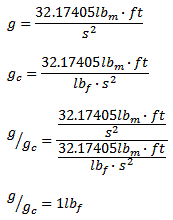- Location
- Connecticut
- Occupation
- Engineer
While it may not agree with SI unit fanaticsroll
maximum force on the bottom of the tank can be in pounds. Pounds divided by pressure (maximum height in ft ? density in lbs/ft?, such as 62.43lb/ft? for water) will yield the maximum bottom of tank area... and we already have the maximum height. Multiply those two together and you have the minimum volume the tank can be to achieve the maximum load... I think :roll:

I've got my problems with SI also, but it may have saved you from a fatal flaw. A "pound" is not a unit of FORCE, it is a unit of MASS.
Force is mass x acceleration. The english units measure of force is the poundal, which is equal to 1 lb x 1ft/s?.
And height x density doesn't give pressure. HxD would provide an result in units of lb(mass)/ft?. Pressure should have a unit of lb(mass)/(ft x s?).
If you replace pound with poundal in your example above, I think you'll find you don't get where you're trying to go.

